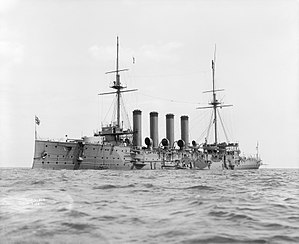HMS Hogue (1900)

Hogue at anchor
|
|
| History | |
|---|---|
|
|
|
| Name: | HMS Hogue |
| Namesake: | Battle of La Hogue |
| Builder: | Vickers, Sons & Maxim, Barrow-in-Furness |
| Laid down: | 14 July 1898 |
| Launched: | 13 August 1900 |
| Completed: | 19 November 1902 |
| Fate: | Sunk by U-9, 22 September 1914 |
| General characteristics | |
| Class and type: | Cressy-class armoured cruiser |
| Displacement: | 12,000 long tons (12,000 t) (normal) |
| Length: | 472 ft (143.9 m) (o/a) |
| Beam: | 69 ft 6 in (21.2 m) |
| Draught: | 26 ft 9 in (8.2 m) (maximum) |
| Installed power: |
|
| Propulsion: |
|
| Speed: | 21 knots (39 km/h; 24 mph) |
| Complement: | 725–760 |
| Armament: |
|
| Armour: | |
HMS Hogue was a Cressy-class armoured cruiser built for the Royal Navy around 1900. Upon completion she was assigned to the Channel Fleet and the China Station. In 1906 she became a training ship for the North America and West Indies Station before being placed in reserve in 1908. Recommissioned at the start of World War I, she played a minor role in the Battle of Heligoland Bight a few weeks after the beginning of the war. Hogue was sunk by the German submarine U-9, together with two of her sister ships, on 22 September 1914. Unlike her sisters, only 48 of her crew were killed in the attack.
Hogue was designed to displace 12,000 long tons (12,000 t). The ship had an overall length of 472 feet (143.9 m), a beam of 69 feet 6 inches (21.2 m) and a deep draught of 26 feet 9 inches (8.2 m). She was powered by two 4-cylinder triple-expansion steam engines, each driving one shaft, which produced a total of 21,000 indicated horsepower (15,660 kW) using steam provided by 30 Belleville boilers. The engines were designed to give a maximum speed of 21 knots (39 km/h; 24 mph), although Hogue reached 22.06 knots (40.86 km/h; 25.39 mph) with 21,432 indicated horsepower (15,982 kW) on her sea trials. She carried a maximum of 1,600 long tons (1,600 t) of coal and her complement ranged from 725 to 760 officers and enlisted men.
...
Wikipedia
